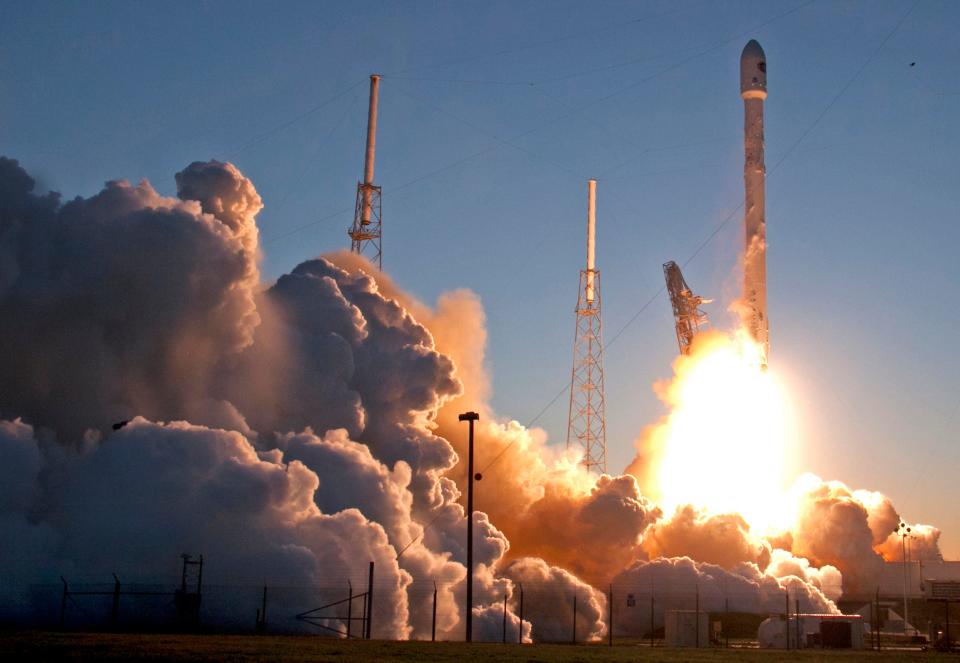Part of one of Elon Musk's SpaceX rockets is expected to crash into the dark side of the moon in March
Part of a SpaceX rocket launched in February 2015 is projected to crash into the dark side of the moon in five weeks.
The Falcon 9 rocket, which lifted off from Cape Canaveral, Florida on Feb. 11, 2015, took the $340 million Deep Space Climate Observatory (DSCOVR) into space.
Four months later, the DSCOVR satellite reached its destination, more than 620,000 miles from Earth, where it continues to send back images daily and track solar storms. The idea for the mission was originally conceived by then-Vice President Al Gore.
But space observers have recently gotten caught up in the ultimate outcome of the Falcon 9 rocket that got DSCOVR into orbit.
Since the rocket's second stage did not have enough fuel to return to Earth or escape "the Earth-Moon system … it has been following a somewhat chaotic orbit since February 2015," wrote Eric Berger, a meteorologist and senior space editor at tech news website Ars Technica, earlier this week.
He cited projections from Bill Gray, who created software astronomers use to track asteroids, comets and near-Earth objects., on the rocket's course to impact the far side of the moon, potentially on March 4.
Elon Musk's Neuralink: Project plans to implant chips in human brains to treat neural disorders
Capsized boat: Body found as 'dire' search off Florida continues for 38 people: What we know

Gray said on his Project Pluto site that he is "100% certain" the rocket will hit the moon at that time on March 4, but added that "space junk can be a little tricky."
In the coming month, additional observations will help 'refine the prediction" and "bring the uncertainty down greatly," Gray wrote.
The prediction is accurate and NASA is monitoring the trajectory of the Falcon 9 rocket's second stage, Karen Fox, NASA's senior science communications officer, said in a statement to USA TODAY.
"On its current trajectory, the second stage is expected to impact the far side of the Moon on March 4, 2022," she said.
NASA’s Lunar Reconnaissance Orbiter (LRO) won't be able to monitor the March 4 impact in real-time, Fox said. "However, the mission team is assessing if observations can be made to any changes to the lunar environment associated with the impact and later identify the crater formed by the impact," she said. "This unique event presents an exciting research opportunity."
NASA hopes to use the orbiter's cameras to find the impact site and compare before and after images. "The search for the impact crater will be challenging and might take weeks to months," Fox said.
SpaceX – selected by NASA to convey the next Americans to land on the moon – did not respond to a request for comment.
The March 4 impact cannot be observed from Earth, since it will occur on the far side of the moon (it's not really dark, it's just that we can't see it from Earth). Still, scientists could possibly learn something by later investigating the rocket's impact.
"This is a rare occurrence, but we have intentionally impacted the moon with rocket upper stages in the past with Apollo missions and with the NASA LCROSS mission, and with various spacecraft," said Bruce Betts, chief scientist at The Planetary Society and manager of its LightSail Program. "To my knowledge, this is the first accidental impact."
Talk about the impact has apparently led to some concerns on social media about it potentially changing the moon's orbit, which Gray attempted to tamper down.
Sure, the rocket weighs about four tons and will be traveling at more than 5,700 miles per hour. However, he noted, "the moon is fairly routinely hit with larger objects moving in the ballpark of 10-20" kilometers per second, which is more than three times as fast as the SpaceX rocket will be traveling.
"Hence, the craters," Gray said. "It's well-built to take that sort of abuse."
Harvard University astrophysicist Jonathan McDowell tweeted that the collision "is interesting, but not a big deal."
For those asking: yes, an old Falcon 9 second stage left in high orbit in 2015 is going to hit the moon on March 4. It's interesting, but not a big deal.
— Jonathan McDowell (@planet4589) January 25, 2022
However, in his Jonathan's Space Report blog, he noted that the attention might bring attention to a growing space junk situation.
"This is not 'SpaceX did something bad' – it's perfectly standard practice to abandon stuff in deep orbit – this is 'none of the space agencies care about leaving stuff out beyond the Moon'," McDowell wrote.
"Traffic in deep space is increasing. And it's not just the USA and the USSR sending stuff to deep space, it's many countries and even commercial companies like SpaceX," he wrote. "So I think it's time for the world to get more serious about regulating and cataloging deep space activity."
Follow Mike Snider on Twitter: @mikesnider.
This article originally appeared on USA TODAY: Elon Musk's SpaceX rocket to hit dark side of the moon in March

 Yahoo Movies
Yahoo Movies 